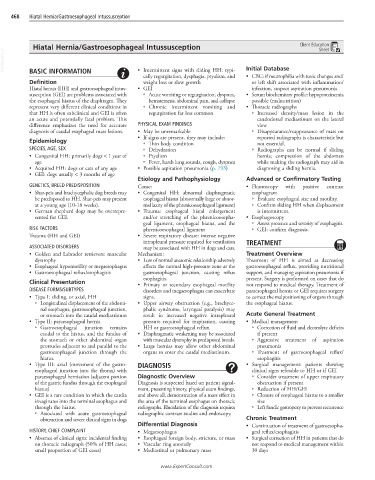Page 953 - Cote clinical veterinary advisor dogs and cats 4th
P. 953
468 Hiatal Hernia/Gastroesophageal Intussusception
Hiatal Hernia/Gastroesophageal Intussusception Client Education
Sheet
VetBooks.ir Initial Database
• Intermittent signs with sliding HH: typi-
BASIC INFORMATION
cally regurgitation, dysphagia, ptyalism, and • CBC: if neutrophilia with toxic changes and/
Definition weight loss or slow growth or left shift associated with inflammation/
Hiatal hernia (HH) and gastroesophageal intus- • GEI infection, suspect aspiration pneumonia
susception (GEI) are problems associated with ○ Acute vomiting or regurgitation, dyspnea, • Serum biochemistry profile: hypoproteinemia
the esophageal hiatus of the diaphragm. They hematemesis, abdominal pain, and collapse possible (malnutrition)
represent very different clinical conditions in ○ Chronic intermittent vomiting and • Thoracic radiographs
that HH is often subclinical and GEI is often regurgitation far less common ○ Increased density/mass lesion in the
an acute and potentially fatal problem. This caudodorsal mediastinum on the lateral
difference emphasizes the need for accurate PHYSICAL EXAM FINDINGS view
diagnosis of caudal esophageal mass lesions. • May be unremarkable ○ Disappearance/reappearance of mass on
• If signs are present, they may include: repeated radiographs is characteristic but
Epidemiology ○ Thin body condition not essential.
SPECIES, AGE, SEX ○ Dehydration ○ Radiographs can be normal if sliding
• Congenital HH: primarily dogs < 1 year of ○ Ptyalism hernia; compression of the abdomen
age ○ Fever, harsh lung sounds, cough, dyspnea while making the radiograph may aid in
• Acquired HH: dogs or cats of any age • Possible aspiration pneumonia (p. 793) diagnosing a sliding hernia.
• GEI: dogs usually < 3 months of age
Etiology and Pathophysiology Advanced or Confirmatory Testing
GENETICS, BREED PREDISPOSITION Cause: • Fluoroscopy with positive contrast
• Shar-peis and brachycephalic dog breeds may • Congenital HH: abnormal diaphragmatic esophagram
be predisposed to HH. Shar-peis may present esophageal hiatus (abnormally large or abnor- ○ Evaluate esophageal size and motility.
at a young age (10-18 weeks). mal laxity of the phrenicoesophageal ligament) ○ Confirm sliding HH when displacement
• German shepherd dogs may be overrepre- • Trauma: esophageal hiatal enlargement is intermittent.
sented for GEI. and/or stretching of the phrenicoesopha- • Esophagoscopy
geal ligament, esophageal hiatus, and the ○ Assess presence and severity of esophagitis.
RISK FACTORS phrenicoesophageal ligament ○ GEI: confirm diagnosis.
Trauma (HH and GEI) • Severe respiratory disease: intense negative
intrapleural pressure required for ventilation TREATMENT
ASSOCIATED DISORDERS may be associated with HH in dogs and cats.
• Golden and Labrador retrievers: muscular Mechanism: Treatment Overview
dystrophy • Loss of normal anatomic relationship adversely Treatment of HH is aimed at decreasing
• Esophageal hypomotility or megaesophagus affects the normal high-pressure zone at the gastroesophageal reflux, providing nutritional
• Gastroesophageal reflux/esophagitis gastroesophageal junction, causing reflux support, and managing aspiration pneumonia if
esophagitis. present. Surgery is performed on cases that do
Clinical Presentation • Primary or secondary esophageal motility not respond to medical therapy. Treatment of
DISEASE FORMS/SUBTYPES disorders and megaesophagus can exacerbate paraesophageal hernia or GEI requires surgery
• Type I: sliding, or axial, HH signs. to correct the malpositioning of organs through
○ Longitudinal displacement of the abdomi- • Upper airway obstruction (e.g., brachyce- the esophageal hiatus.
nal esophagus, gastroesophageal junction, phalic syndrome, laryngeal paralysis) may
or stomach into the caudal mediastinum result in increased negative intrapleural Acute General Treatment
• Type II: paraesophageal hernia pressure required for inspiration, causing • Medical management
○ Gastroesophageal junction remains HH or gastroesophageal reflux. ○ Correction of fluid and electrolyte deficits
caudal to the hiatus, and the fundus of • Diaphragmatic weakening may be associated if present
the stomach or other abdominal organ with muscular dystrophy in predisposed breeds. ○ Aggressive treatment of aspiration
protrudes adjacent to and parallel to the • Large hernias may allow other abdominal pneumonia
gastroesophageal junction through the organs to enter the caudal mediastinum. ○ Treatment of gastroesophageal reflux/
hiatus. esophagitis
• Type III: axial (movement of the gastro- DIAGNOSIS • Surgical management: patients showing
esophageal junction into the thorax) with clinical signs referable to HH or if GEI
paraesophageal herniation (adjacent portion Diagnostic Overview ○ Consider treatment of upper respiratory
of the gastric fundus through the esophageal Diagnosis is suspected based on patient signal- obstruction if present
hiatus) ment, presenting history, physical exam findings, ○ Reduction of HH/GEI
• GEI is a rare condition in which the cardia and above all, demonstration of a mass effect in ○ Closure of esophageal hiatus to a smaller
invaginates into the terminal esophagus and the area of the terminal esophagus on thoracic size
through the hiatus. radiographs. Elucidation of the diagnosis requires ○ Left fundic gastropexy to prevent recurrence
○ Associated with acute gastroesophageal radiographic contrast studies and endoscopy.
obstruction and severe clinical signs in dogs Chronic Treatment
Differential Diagnosis • Continuation of treatment of gastroesopha-
HISTORY, CHIEF COMPLAINT • Megaesophagus geal reflux/esophagitis
• Absence of clinical signs: incidental finding • Esophageal foreign body, stricture, or mass • Surgical correction of HH in patients that do
on thoracic radiograph (50% of HH cases; • Vascular ring anomaly not respond to medical management within
small proportion of GEI cases) • Mediastinal or pulmonary mass 30 days
www.ExpertConsult.com

